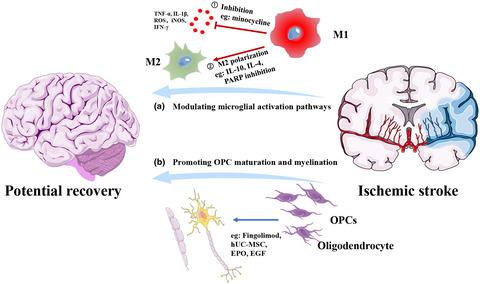当前位置:
X-MOL 学术
›
J. Neurosci. Res.
›
论文详情
Our official English website, www.x-mol.net, welcomes your feedback! (Note: you will need to create a separate account there.)
White matter injury in the neonatal hypoxic‐ischemic brain and potential therapies targeting microglia
Journal of Neuroscience Research ( IF 4.2 ) Pub Date : 2021-01-08 , DOI: 10.1002/jnr.24761 Rongjiao Shao 1 , Dawei Sun 1 , Yue Hu 1 , Derong Cui 1
Journal of Neuroscience Research ( IF 4.2 ) Pub Date : 2021-01-08 , DOI: 10.1002/jnr.24761 Rongjiao Shao 1 , Dawei Sun 1 , Yue Hu 1 , Derong Cui 1
Affiliation

|
Neonatal hypoxic–ischemic (H‐I) injury, which mainly causes neuronal damage and white matter injury (WMI), is among the predominant causes of infant morbidity (cerebral palsy, cognitive and persistent motor disabilities) and mortality. Disruptions to the oxygen and blood supply in the perinatal brain affect the cerebral microenvironment and may affect microglial activation, excitotoxicity, and oxidative stress. Microglia are significantly associated with axonal damage and myelinating oligodendrocytes, which are major pathological components of WMI. However, the effects of H‐I injury on microglial functions and underlying transformation mechanisms remain poorly understood. The historical perception that these cells are major risk factors for ischemic stroke has been questioned due to our improved understanding of the diversity of microglial phenotypes and their alterable functions, which exacerbate or attenuate injuries in different regions in response to environmental instability. Unfortunately, although therapeutic hypothermia is an efficient treatment, death and disability remain the prognosis for a large proportion of neonates with H‐I injury. Hence, novel neuroprotective therapies to treat WMI following H‐I injury are urgently needed. Here, we review microglial mechanisms that might occur in the developing brain due to neonatal H‐I injury and discuss whether microglia function as a double‐edged sword in WMI. Then, we emphasize microglial heterogeneity, notably at the single‐cell level, and sex‐specific effects on the etiology of neurological diseases. Finally, we discuss current knowledge of strategies aiming to improve microglia modulation and remyelination following neonatal H‐I injury. Overall, microglia‐targeted therapy might provide novel and valuable insights into the treatment of neonatal H‐I insult.
中文翻译:

新生儿缺氧缺血脑白质损伤和针对小胶质细胞的潜在疗法
新生儿缺氧缺血 (H-I) 损伤主要导致神经元损伤和白质损伤 (WMI),是婴儿发病率(脑瘫、认知和持续性运动障碍)和死亡的主要原因之一。围产期大脑中氧气和血液供应的中断会影响大脑微环境,并可能影响小胶质细胞的激活、兴奋性毒性和氧化应激。小胶质细胞与轴突损伤和髓鞘少突胶质细胞显着相关,它们是 WMI 的主要病理成分。然而,H-I 损伤对小胶质细胞功能和潜在转化机制的影响仍然知之甚少。由于我们对小胶质细胞表型的多样性及其可变功能的理解加深,这些细胞是缺血性中风的主要危险因素的历史认知受到质疑,这些功能会因环境不稳定而加剧或减轻不同区域的损伤。不幸的是,尽管低温治疗是一种有效的治疗方法,但死亡和残疾仍然是大部分患有 H-I 损伤的新生儿的预后因素。因此,迫切需要新的神经保护疗法来治疗 H-I 损伤后的 WMI。在这里,我们回顾了由于新生儿 H-I 损伤而在发育中的大脑中可能发生的小胶质细胞机制,并讨论小胶质细胞是否在 WMI 中起到双刃剑的作用。然后,我们强调小胶质细胞的异质性,特别是在单细胞水平上,和性别特异性对神经系统疾病病因的影响。最后,我们讨论了旨在改善新生儿 H-I 损伤后小胶质细胞调节和髓鞘再生的策略的当前知识。总体而言,小胶质细胞靶向治疗可能为新生儿 H-I 损伤的治疗提供新颖而有价值的见解。
更新日期:2021-02-21
中文翻译:

新生儿缺氧缺血脑白质损伤和针对小胶质细胞的潜在疗法
新生儿缺氧缺血 (H-I) 损伤主要导致神经元损伤和白质损伤 (WMI),是婴儿发病率(脑瘫、认知和持续性运动障碍)和死亡的主要原因之一。围产期大脑中氧气和血液供应的中断会影响大脑微环境,并可能影响小胶质细胞的激活、兴奋性毒性和氧化应激。小胶质细胞与轴突损伤和髓鞘少突胶质细胞显着相关,它们是 WMI 的主要病理成分。然而,H-I 损伤对小胶质细胞功能和潜在转化机制的影响仍然知之甚少。由于我们对小胶质细胞表型的多样性及其可变功能的理解加深,这些细胞是缺血性中风的主要危险因素的历史认知受到质疑,这些功能会因环境不稳定而加剧或减轻不同区域的损伤。不幸的是,尽管低温治疗是一种有效的治疗方法,但死亡和残疾仍然是大部分患有 H-I 损伤的新生儿的预后因素。因此,迫切需要新的神经保护疗法来治疗 H-I 损伤后的 WMI。在这里,我们回顾了由于新生儿 H-I 损伤而在发育中的大脑中可能发生的小胶质细胞机制,并讨论小胶质细胞是否在 WMI 中起到双刃剑的作用。然后,我们强调小胶质细胞的异质性,特别是在单细胞水平上,和性别特异性对神经系统疾病病因的影响。最后,我们讨论了旨在改善新生儿 H-I 损伤后小胶质细胞调节和髓鞘再生的策略的当前知识。总体而言,小胶质细胞靶向治疗可能为新生儿 H-I 损伤的治疗提供新颖而有价值的见解。

























 京公网安备 11010802027423号
京公网安备 11010802027423号